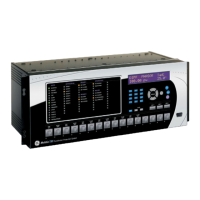GE Multilin T35 Transformer Protection System 1-5
1 GETTING STARTED 1.2 UR OVERVIEW
1
1.2.3 SOFTWARE ARCHITECTURE
The firmware (software embedded in the relay) is designed in functional modules that can be installed in any relay as
required. This is achieved with object-oriented design and programming (OOD/OOP) techniques.
Object-oriented techniques involve the use of objects and classes. An object is defined as “a logical entity that contains
both data and code that manipulates that data”. A class is the generalized form of similar objects. By using this concept,
one can create a protection class with the protection elements as objects of the class, such as time overcurrent, instanta-
neous overcurrent, current differential, undervoltage, overvoltage, underfrequency, and distance. These objects represent
completely self-contained software modules. The same object-class concept can be used for metering, input/output control,
software interface, communications, or any functional entity in the system.
Employing OOD/OOP in the software architecture of the T35 achieves the same features as the hardware architecture:
modularity, scalability, and flexibility. The application software for any UR-series device (for example, feeder protection,
transformer protection, distance protection) is constructed by combining objects from the various functional classes. This
results in a common interface across the UR series.
1.2.4 IMPORTANT CONCEPTS
As described above, the architecture of the UR-series relays differ from previous devices. To achieve a general understand-
ing of this device, some sections of Chapter 5 are quite helpful. The most important functions of the relay are contained in
“elements”. A description of the UR-series elements can be found in the Introduction to elements section in chapter 5.
Examples of simple elements, and some of the organization of this manual, can be found in the Control elements section of
chapter 5. An explanation of the use of inputs from CTs and VTs is in the Introduction to AC sources section in chapter 5. A
description of how digital signals are used and routed within the relay is contained in the Introduction to FlexLogic section in
chapter 5.

